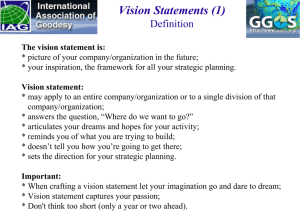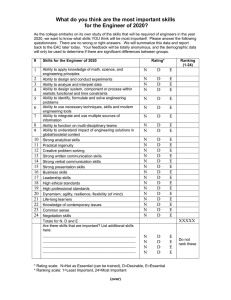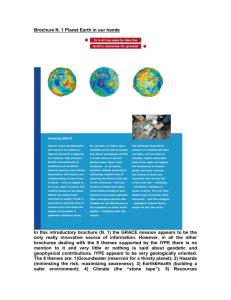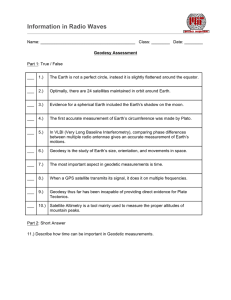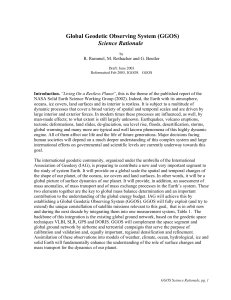Geodetic Reference Frame
advertisement
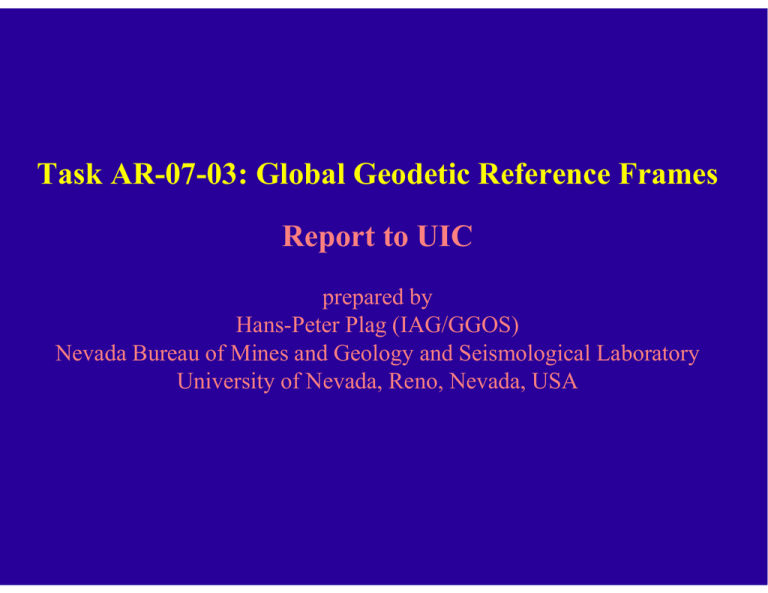
Task AR-07-03: Global Geodetic Reference Frames Report to UIC prepared by Hans-Peter Plag (IAG/GGOS) Nevada Bureau of Mines and Geology and Seismological Laboratory University of Nevada, Reno, Nevada, USA Task AR-07-03: Global Geodetic Reference Frames “Ensure the availability of accurate, consistent, homogeneous, longterm stable, global geodetic reference frames as a mandatory framework and the metrological basis for Earth observation.” Two Goals: User requirement coordination: Establish a comprehensive GEOSS database of user requirements concerning georeferencing and geodetic reference frames by identifying, describing and establishing links to relevant user communities in the nine societal benefit areas and conducting appropriate surveys. Georeferencing: Ensure the availability of appropriate global geodetic reference frames for GEOSS. Task proposed by International Association of Geodesy (IAG)/Global Geodetic Observing System (GGOS) Task Progress and Status: POC: IAG/GGOS (Hans-Peter Plag) Lead organization: IAG/GGOS Current contributions: - Germany - CEOS - IAG/GGOS - Korea - Italy - U,K. (expected to become member) Additional contributions: - Through GGOS 2020: more than 40 Experts (including IGOS-P, GLOSS, GOOS, GCOS) Deliverables in 2007: GGOS 2020 Reports GEO/GGOS 2007 Workshop GG S 2020 The Global Geodetic Observing System: Meeting the Requirements of a Global Society on a Changing Planet in 2020 (GGOS 2020) Strategy process of GGOS/IAG Deliverable of Task AR-07-03 Basis for the future development and implementation of GGOS Time Schedule GG S 2020 Request for Strategy paper of the GGOS Steering Committee in April 2006 First draft Reference document available on October 5, 2006 for GGOS Workshop January/February 2007: Reviewer team established (eight reviewers) GGOS Retreat and GGOS 2020 SWT Meeting, February 19-22, 2007, Oxnard, California May 24, 2007: Version 0.17 released for internal hearing in IAG August – October 2007: Hearing phase, including GEO, IGOS-P, IUGG, national authorities and space agencies Final documents available end of October for GEO Plenary, November 2007 Expected Output GG S 2020 Two documents: - Strategy document: short document for policy and decision makers, funding agencies - Reference document: long, comprehensive document with all the user requirements and details of GGOS in 2020 mainly for those actually doing the work In the following: Brief (executive) summary of the Reference Document Contents GG S 2020 About this document Executive Summary 1. Introduction 2. The goals, achievements, and tools of geodesy 3. Understanding a dynamic planet: Earth science requirements for geodesy 4. Maintaining a modern society 5. Earth observation: Serving the needs of an increasingly global society 6. Geodesy: foundation for exploring the planets, the solar system and beyond 7. Integrated scientific and societal user requirements and functional specifications for the GGOS 8. The future geodetic reference frame 9. The future Global Geodetic Observing System (GGOS) 10.Towards GGOS in 2020 11.Recommendations Appendices Writing Team Editors: Chapter 1: Chapter 2: Chapter 3: Chapter 4: Chapter 5: Chapter 6: Chapter 7: Chapter 8: Chapter 9: Chapter 10: Chapter 11: GG S 2020 H.-P. Plag, M. Pearlman H.-P. Plag, all other lead authors H.-P. Plag, Z. Altamimi, S. Bettadpur, G. Beutler, G. Beyerle, A. Cazenave, D. Crossley, A. Donnellan, R. Forsberg, R. Gross, J. Hinderer, A. Komjhathy, A. J. Mannucci, C. Ma, C. Noll, A. Nothnagel, E. C. Pavlis, M. Pearlman, P. Poli, U. Schreiber, K. Senior, P. Woodworth R. Rummel, G. Beutler, V. Dehant, R. Gross, K.H. Ilk, H.-P. Plag, P. Poli, M. Rothacher, S. Stein, R. Thomas, J. Wahr, P.L. Woodworth, S. Zerbini, V. Zlotnicki C. Rizos, D. Brzezinska, R. Forsberg, G. Johnston, S. Kenyon, D. Smith, D. Sahagian, J. Abshire, D. Alsdorf, P. Davis, P. Houser, C. Kreemer, J. Melack, M. Pearlman, H.-P. Plag, P. Poli, S. Reid, M. Rodell, R. Thomas J. Zumberge, J. S. Border, V. Dehant, W.M. Folkner, D.L. Jones, T. Martin-Mur, J. Oberst, J.G. Williams, X. Wu R. Gross, G. Beutler, H.-P. Plag T. Herring, Z. Altamimi, H.-P. Plag, P. Pauli, J.Ray M. Rothacher, G. Beutler, W. Bosch, A. Donnellan, R. Gross, J. Hinderer, C. Ma, M. Pearlman, J. Ries, H. Schuh, F. Seitz, C.K. Shum, D. Smith, M. Thomas, E. Velacognia, J. Wahr, P. Willis G. Beutler, M. Pearlman, H.-P. Plag, R. Neilan, M. Rothacher, R. Rummel All lead authors Executive Summary GG S 2020 Chapter 1: Geodesy is fundamental in meeting the challenge of living on a changing, dynamic planet with limited resources and a limited capacity to handle anthropogenic interference Chapter 2: Geodesy is in a transition, if not a revolution (methods, techniques, accuracy): * Transition from a static view to a dynamic Earth system approach; * Transition from service provider to information provider. Executive Summary GG S 2020 Chapter 2 (cont.): Impressive overview of geodesy's contribution to monitoring of the Earth: * Reference frames (terrestrial and celestial) for accurate positions and motion trajectories; * Earth's geometry: shape of solid Earth, ocean, ice sheets, water surfaces; * Earth's gravity field: static: mass distribution, geoid; variable: mass transport, mainly water cycle; * Earth's rotation: dynamics, interaction solid Earth and fluid envelope; * Auxiliary observations and applications: atmosphere, ionosphere, tide gauges, time and frequency transfer. International cooperation is essential for geodesy Executive Summary GG S 2020 Executive Summary GG S 2020 Tide Gauges Laser http://icesat.gsfc.nasa.gov http://sealevel.colorado.edu/tidegauges.html GRACE GNSS Reflections Zufada & Zavorotny (2004) Satellite Altimetry Radar Courtesy NASA/JPL-Caltech Executive Summary GG S 2020 Chapter 3: (Space-)geodetic observations have fundamentally contributed to understanding key process (e.g. tectonics, earthquakes, volcanoes, water cycle, sea level, ice sheets); Geodesy has the potential to contribute more; Requirements: increased spatial and temporal resolution, increased accuracy, increased long-term stability; Consistency across the three 'pillars of geodesy'; Transition from separation of effects to integration: Earth system model approach The development of the geodetic observing system needs research: overarching theme for IAG Executive Summary GG S 2020 Chapter 4: Societal prospects of Geodesy: contribution is (almost) everywhere: Spatial data infrastructure, navigation, engineering, land survey, and mapping, timing applications, early warning and emergency management, infomobility, management of and access to resources, monitoring the environment and improving predictability; Societal and economic benefits of the global and national infrastructure are enormous: Reference frames are fundamentally important; Current requirements are demanding (particularly for positioning); Requirements are expected to increase. Executive Summary GG S 2020 Chapter 5: Geodesy is developing into a geodetic Earth system service; Geodetic services and products are crucial for the utilization of the benefits of Earth observations. Disasters: earthquakes, volcanoes, landslides, tsunamis, storms, subsidence, floods; Energy resources: wind, subsidence, geothermal, monitoring of infrastructure; Climate change: ocean and atmospheric circulation; Water: global and regional water cycle, sea level, fresh water resources, lakes, streams, ground water, ice, dams, water mass redistribution, soil moisture; Weather: enhancing prediction tools, extreme events, space weather; Ecosystems and Carbon cycle: Land cover (forests, desertification), wetlands, monitoring of CO2; Agriculture: land use, irrigation, deforestation, desertification, erosion/deposition, urbanization. Executive Summary GG S 2020 Chapter 6: Geodesy is essential for exploring the planets, solar system, and beyond Chapter 7: User requirements for geodetic observations and products are demanding position: centimeter in real time, mm in post-processing, 0.1 mm/yr over many decades static geoid: 1 mm, 0.1 mm/yr time-variable geoid: 1 mm, spatial Earth orientation: 1 mm, spatial resolution of 50 km, temporal resolution 10 days Functional specifications based on demanding but highly relevant applications Executive Summary GG S 2020 Chapter 8: Transition from 'polyhedron' with low spatial resolution to high-resolution reference frame; Future terrestrial reference frame has to be based on a 'dynamic Earth reference model' (based on data assimilation); Reference frame (position and motion) available anywhere, any time; Anomalous motion: deviation of observed from predicted reference motion. Chapter 9: Infrastructure for geodetic Earth system monitoring: * multi-layered (5 layers); * operational core. Executive Summary GG S 2020 Executive Summary GG S 2020 Executive Summary GG S 2020 Chapter 10: Implementation of GGOS needs an multi-faceted organizational framework Operational core requires intergovernmental agreements/support Executive Summary GG S 2020 Executive Summary GG S 2020 Executive Summary GG S 2020 Chapter 11: more than 30 recommendations (infrastructure, concepts, models, organization, actions), operational core, continuous satellite missions (in particular altimetry, gravity, InSAR). Future Activities Contribution to International Geohazards Week, November 5-9, 2007: Future Activities GEO(?)/GGOS Stakeholder conference in March 2008. Community of Practice (?)
